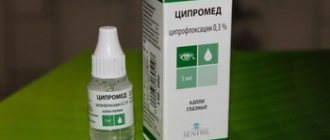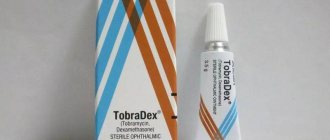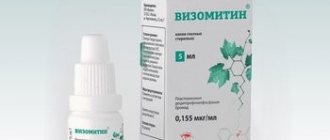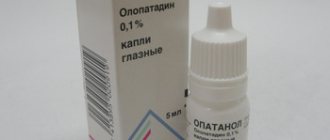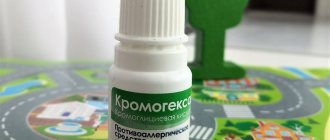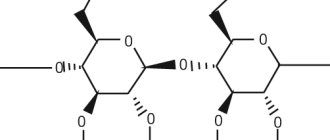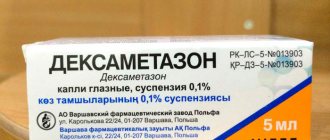Mydriacyl drops are a Belgian-made m-cholinomimetic. After instillation, sensitivity is removed from the eye receptors and the ciliary muscle is paralyzed. The main effect is the dilation of the pupil, due to which it is possible to examine the condition of the fundus, blood vessels, detect adhesions and other pathological processes that cannot be detected with a constricted pupil.
How the drug works
Midriacil (Latin name - Mydriacyl) belongs to the group of drugs M-anticholinergics. This is the name for drugs that block M-cholinergic receptors, which are responsible for the tone of muscle tissue. When Mydriacyl is instilled into the eyes, the iris valve and the ciliary (ciliary) muscle of the eyeball relax. This contributes to the development of mydriasis (dilation of the pupillary space) and paralysis of accommodation. As a result, the ability to clearly see objects located at different distances from the observer is temporarily lost.
The action of Midriacil begins 5-10 minutes after instillation. The maximum effect from its use develops after 20 minutes and lasts up to 2 hours. The effect of the drug completely stops after about 6 hours. Then the accommodation of the eye and the ability of the pupil to constrict are restored.
Attention! With a single use of Mydriacyl, only mydriasis can be achieved, since this will not be enough to relax the ciliary muscle. To achieve cycloplegia (paralysis of accommodation), it is necessary to instill drops several times at a given time interval. Typically, paralysis of the ciliary muscle occurs 25 minutes after the second or subsequent installation and lasts an average of half an hour. Accommodation is completely restored after 3 hours.
pharmachologic effect
Tropicamide after instillation leads to pupil dilation. With repeated procedures, paralysis of accommodation develops, which is characterized by impaired visual perception. However, this condition allows the doctor to assess the cause of decreased vision: the development of spasm of the ciliary muscle or true myopia. Also, accommodation paralysis can improve the patient’s well-being in certain pathologies.
The maximum pharmacological effect occurs 20 minutes after instillation of eye drops and lasts up to 3 hours. Complete normalization of the condition occurs within 6 hours after using Midriacil.
Composition and release forms of the drug
The main substance of Mydriacyl is tropicamide. The product is available in the form of eye drops containing the active ingredient in a solution of 0.5% and 1%.
The drops also include:
- Distilled water;
- Table salt;
- Tritlon B;
- Benzalkonium chloride compounds;
- Hydrogen chloride and/or sodium hydroxide (to adjust pH).
The drops look like a clear, colorless solution placed in a bottle with a dropper.
Analogs
The most popular products that have the same active ingredient as Midriacil are Tropicamide and Midax eye drops. Similar products in action, indications for use, with a different composition:
- Midrimax.
- Atropine.
- Cyclomed.
Ophthalmic drops with a different composition, similar indications: Irifrin - to dilate the pupil, reduce pressure inside the eye, Mezaton - used when examining the back wall of the eye.
What is it prescribed for?
According to the official instructions for the use of Mydriacyl eye drops, the following are prescribed:
- To increase the pupillary space before examining the fundus or performing laser or surgical operations on the internal structures of the eyeball;
- For paralysis of accommodation, necessary to establish refraction (optical power of the eye);
- For the treatment of eye infections in combination with other drugs;
- To prevent adhesions (overgrowth of connective tissue) and synechiae (tissue fusion) after eye surgery.
Important! Midriacil is used strictly as prescribed by an ophthalmologist. Self-medication can cause disruption of the visual apparatus.
special instructions
Caution should be exercised when using Midriacil in patients who:
- The IOP (intraocular pressure) indicator is above normal;
- Small size of the anterior chamber of the eye (increases the risk of increased IOP);
- IOP was not measured before installation in the eyes.
In the absence of eye damage, the absorption of tropicamide into the bloodstream is negligible. However, its penetration is significant if Midriacil is used for inflammatory diseases and redness of the conjunctival membrane. This increases the risk of developing common side effects.
Important! You cannot instill Mydriacyl into the nose, ears, or inject it into the body.
Drug interactions
Medicines with m-cholinergic stimulating effects reduce the severity of the action of Midriacil, adrenergic stimulants act in the opposite way - they enhance the effect. The likelihood of developing negative manifestations of Midriacil can be provoked by: Quinidine, phenothiazines, Amantadine, antiallergic drugs, tricyclic antidepressants.
Directions for use and dosage
Midriacil is installed into the conjunctival cavity of the eye. The dosage of the drug does not depend on the patient’s age:
- To study the internal structures of the eye and fundus, 1-2 drops of the drug are installed. If the pupil dilates poorly, the installation is repeated 5-10 minutes after the first;
- To determine the optical power of the eyes, install 1-2 drops of the drug up to 3 times. An interval of 1/4 to 1/3 hour is maintained between installations;
- To prevent synechiae and adhesions after surgery, as well as in case of infectious diseases of the eye membranes, the dosage and frequency of use of the drug is determined by the attending physician. Typically, the patient is recommended to instill 1 drop every 3-4 hours, excluding night time.
Before diagnostic measures, Midriacil is used once or twice until mydriasis or cycloplegia is achieved. And for therapeutic and preventive purposes it is used in a course, the duration of which is from 5 to 10 days.
When wearing contact lenses, they should be removed before installing the drug in the eyes. You can put them back after a quarter of an hour.
Important! To reduce the penetration of tropicamide into the bloodstream and the likelihood of systemic side effects, after instilling the product, you need to pinch the inner corners of your eyes with your fingers and wait about 2 minutes.
Instructions for use
If only pupil dilation is necessary to examine the fundus of the eye or the child is under 6 years old, use a 0.5% solution. In other cases, a 1% drug is used. If during diagnosis it is necessary to cause paralysis of the ciliary muscle so that a person cannot focus his gaze, instill one drop of a 1% solution. To study the refractive ability of the eyes, 2 drops are instilled, and after 5 minutes the instillation is repeated.
If a person has a very dark iris, it is permissible to administer an additional drop of the drug. If the study lasts more than 40 minutes, the effect of the drug begins to weaken, instillation must be repeated. If severe lacrimation is observed during the administration of the drug, it is recommended to repeat the procedure.
Possible side effects
After installation of Mydricial in the eyes, a burning sensation usually begins, which goes away on its own after some time. The following local reactions develop less frequently:
- Intolerance to bright light;
- Swelling of the membranes and other tissues of the eye;
- Hyperemia (reddening of proteins);
- Increased IOP;
- Point inflammation of the cornea;
- Inflammation of the eyelids and conjunctival membrane.
If tropicamide enters the bloodstream, general adverse reactions may develop:
- Weakness;
- Constant desire to sleep;
- Dryness of the oral mucosa;
- Headache and dizziness;
- Increased heart rate;
- Bloating;
- Allergic reactions (rash, urticaria);
- Impaired intestinal motility (atony) and constipation;
- Bladder atony and inability to empty it;
- Pulmonary-cardiac collapse (respiratory impairment and lack of blood supply to internal organs).
Systemic reactions after installation of Mydriacyl in the eyes most often occur in children and elderly patients.
Overdose
If the dose of Midriacil is exceeded or the drug is ingested, an overdose occurs. It is manifested by the following symptoms:
- Bloating;
- Heart rate disturbances;
- Dryness and rashes on the skin;
- Blurred vision;
- Increased body temperature;
- Convulsions;
- Hallucinations;
- Impaired coordination of movements;
- Coma and paralysis of the respiratory system (if a very large amount of tropicamide enters the blood).
Treatment of an overdose with Mydriacyl involves eliminating its symptoms. If the drug was ingested, the patient is induced to vomit and the stomach is washed. Cold compresses are recommended to moisturize the skin.
Analogues of Midriacil
There are drugs that are analogues of Midriacil both in the active substance and in the medicinal effect. We give a brief overview of them in the table.
| Drug name | Active substance (or their complex) | Indications | Contraindications | Other information | Cost in Russian pharmacies | |
| Irifrin 2.5% and 10% | Phenylephrine hydrochloride |
|
| Unlike Mydriacyl, Irifrin does not lead to paralysis of accommodation. |
| |
| Atropine | Atropine |
|
| Atropine, like Mydriacyl, leads not only to the development of mydriasis, but also causes paralysis of accommodation. Moreover, the effect of the drops begins only after 30-40 minutes, but it lasts up to 4 days. | Bottle (5 ml) – about 17 rubles. | |
| Cycloptic | Cyclopentolate |
|
| Cycloptic acts longer than Mydriacyl, but shorter than Atropine. The effect of use occurs 1-1.5 hours after installation and lasts for 6-12 hours. The effect of Cycloptic completely stops after a day. | Bottle (5 ml) – about 128 rubles. | |
| Tropicamide | Tropicamide | Since the main component of Midriacil and Tropicamide is the same, the indications and contraindications for them are identical. | Tropicamide is produced only in the form of a 1% solution, so these drops are contraindicated for children under 6 years of age. | Bottle (5 ml) – about 120 rubles. | ||
| Midrimax | Tropicamide + phenylephrine |
|
| Due to the presence of tropicamide in the drops, the effect of their use occurs within 10 minutes. And thanks to the content of phenylephrine in the drug, its effect lasts up to 6 hours. | Bottle (5 ml) – from 575 rub. | |
Existing contraindications
It is recommended to stop using Mydriacyl in the following situations:
- the presence of hypersensitivity to any ingredient of the drug;
- with the development of glaucoma (especially dangerous with angle-closure or mixed forms of the disease);
- against the background of increased intraocular pressure;
- Children under 6 years of age are prohibited from Mydriacyl 1%.
Eye drops are prescribed with caution in the presence of inflammatory processes in the eye, because hyperemia significantly increases the systemic absorption of the drug through the conjunctiva.
Reviews
Reviews of Mydriacyl eye drops are mixed.
Antipova T. M. (pharmacist), 27 years old, Kolomna. Mydriacyl cannot be used systematically. And during treatment with it, the patient should not watch TV, work on a PC, write, read or do other work associated with bright light or eye strain. If the doctor prescribed drops, it is better to install them at night, then you will see better during the day.
Veronica (patient), 28 years old, Moscow. I was prescribed Mydriacyl after laser eye correction. I was tormented by eye pain. The doctor explained that they were caused by a spasm of accommodation. The drops helped me get rid of it, so the pain also went away.
Evgenia (patient), 42 years old, St. Petersburg. The doctor prescribed Mydriacyl after eye surgery. After using the drops, I developed dryness, discomfort and burning. But I still continued to use the drug. After a week, the side effects stopped and my vision improved.
Midriacil is an eye drop with a persistent but relatively short-term effect. In modern ophthalmology it is preferred. This is necessary for the rapid restoration of visual function after its use. After installing Atropine, this would be impossible, since the effect of the latter persists for several days.
Storage conditions, expiration date, release from pharmacies
Midriacil drops are dispensed from pharmacies with a doctor's prescription. The medicinal properties of the ophthalmic product are preserved for 3 years from the date of release of the drug indicated on the packaging. After opening, the shelf life is 30 days. Store the product at a temperature of 8° to 30° C, away from sunlight and children.
In Russia, Mydriacyl drops cost an average of 320 rubles. The average price in Moscow is 350 rubles. In Ukraine, the approximate price of Midriacil is 44 UAH. The cost depends on the region of residence and pharmacy chain.
